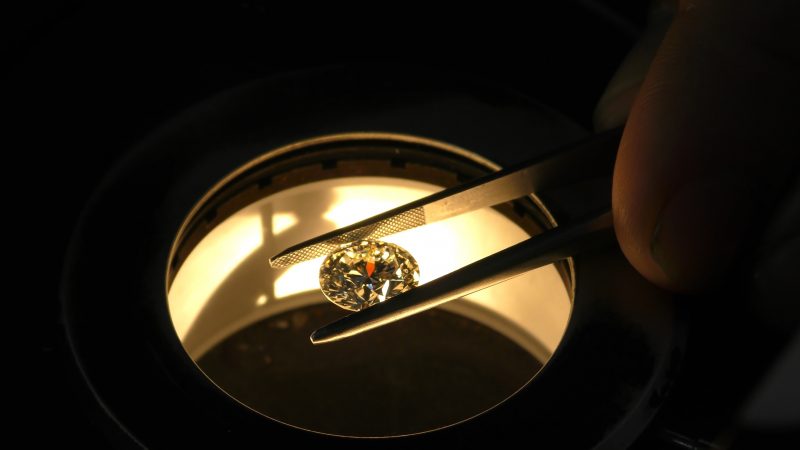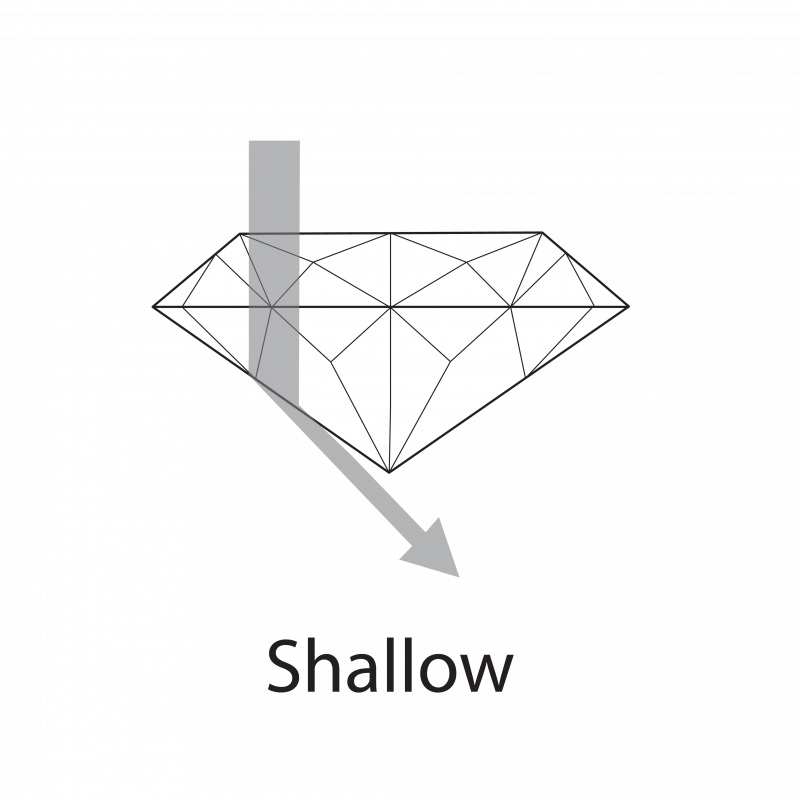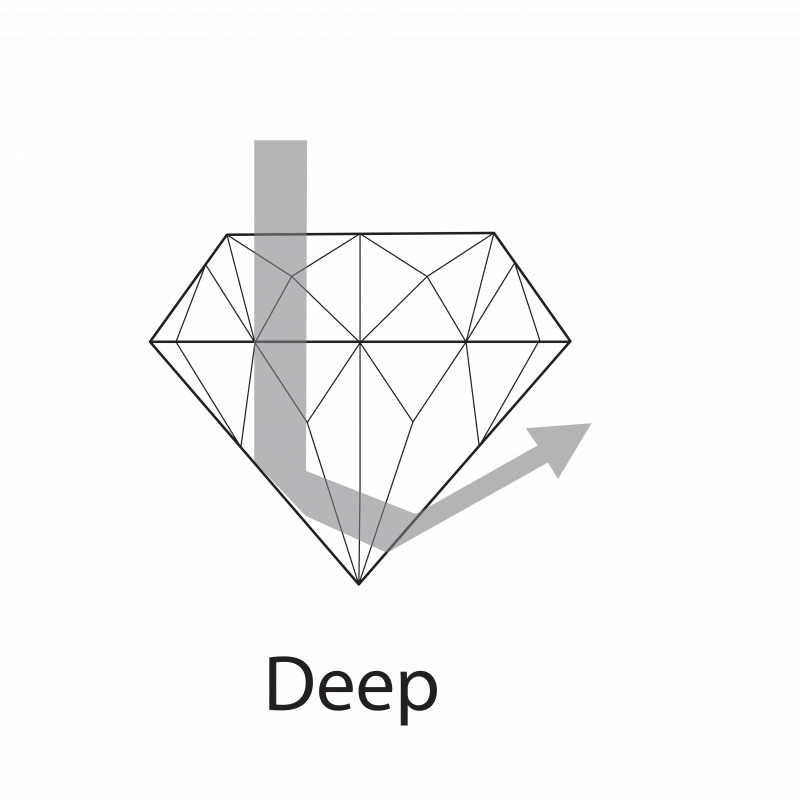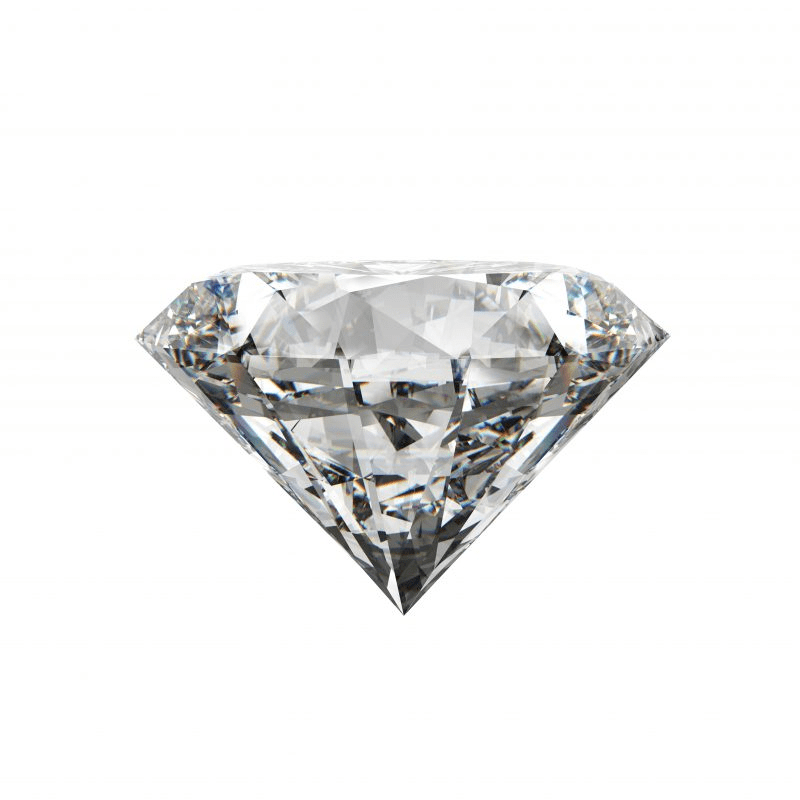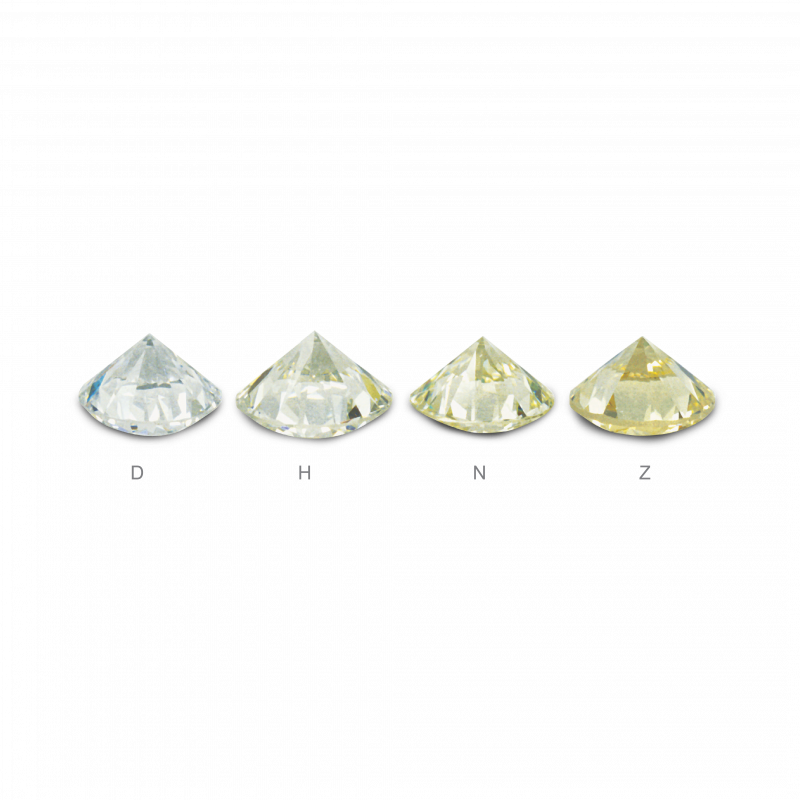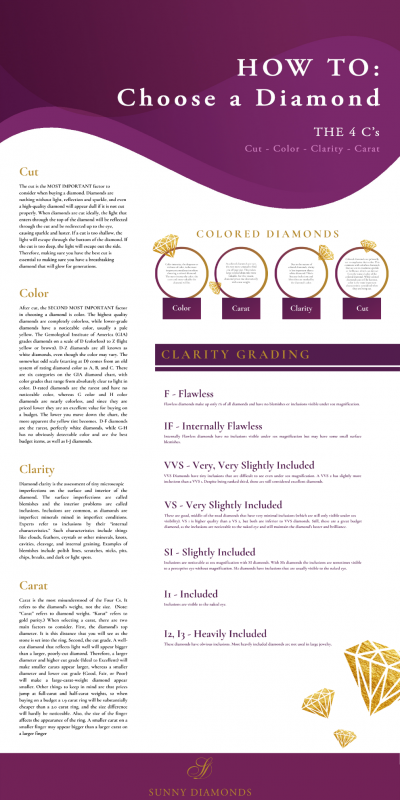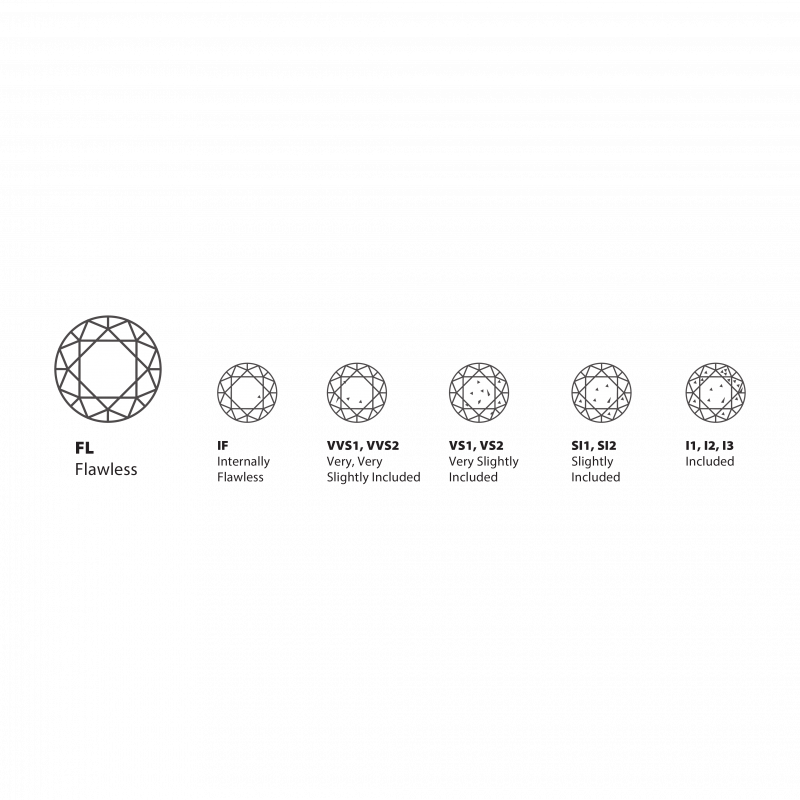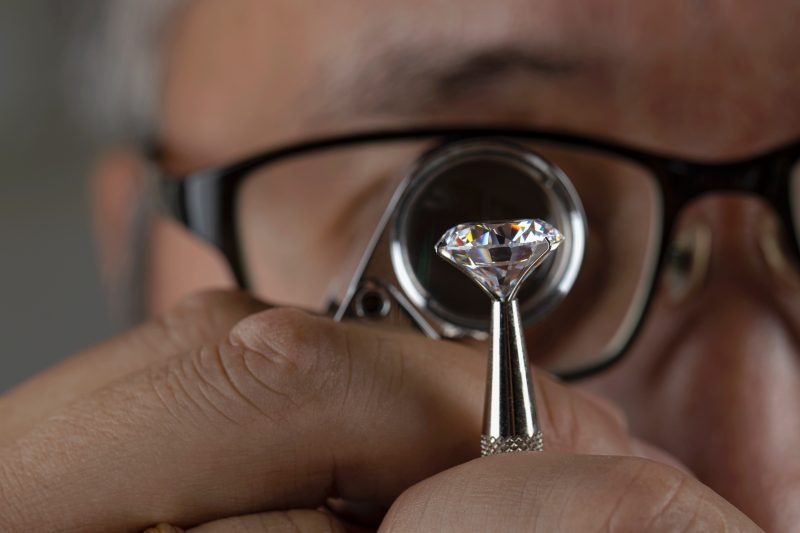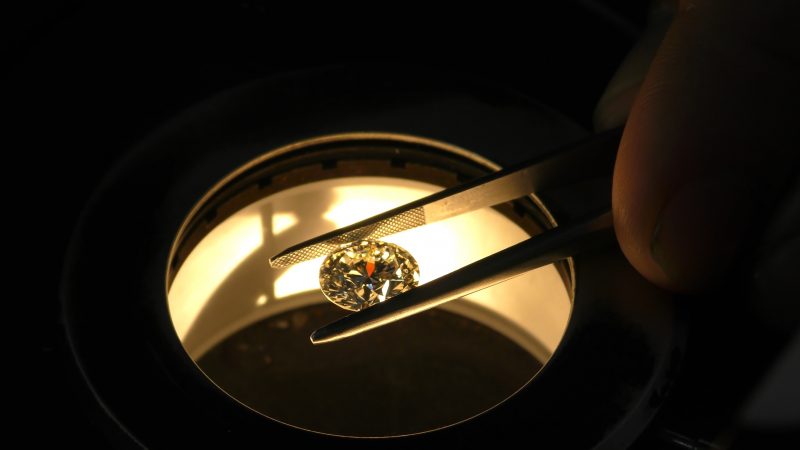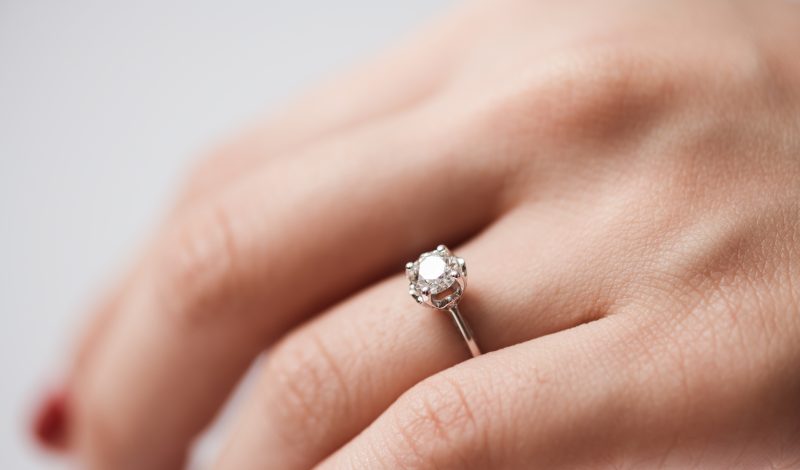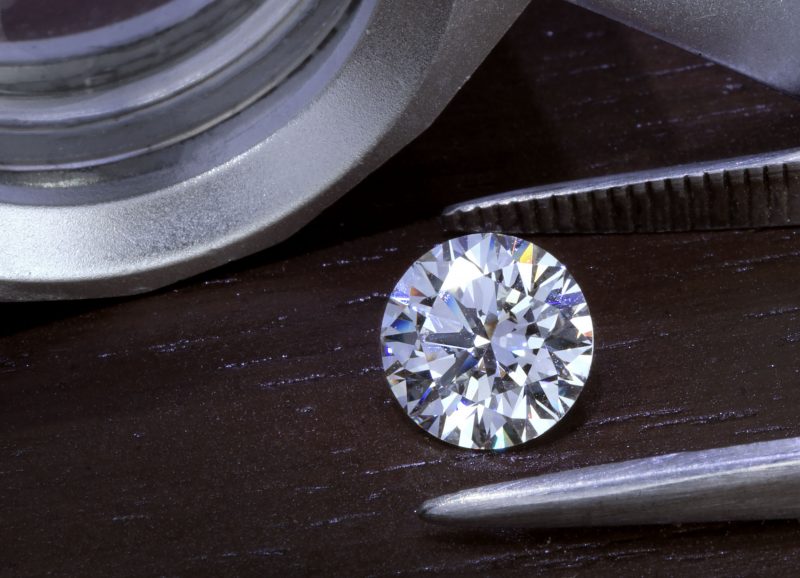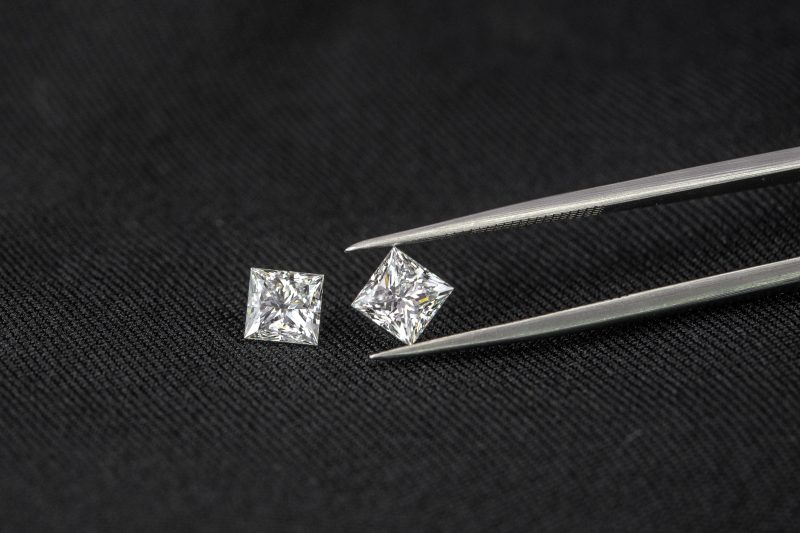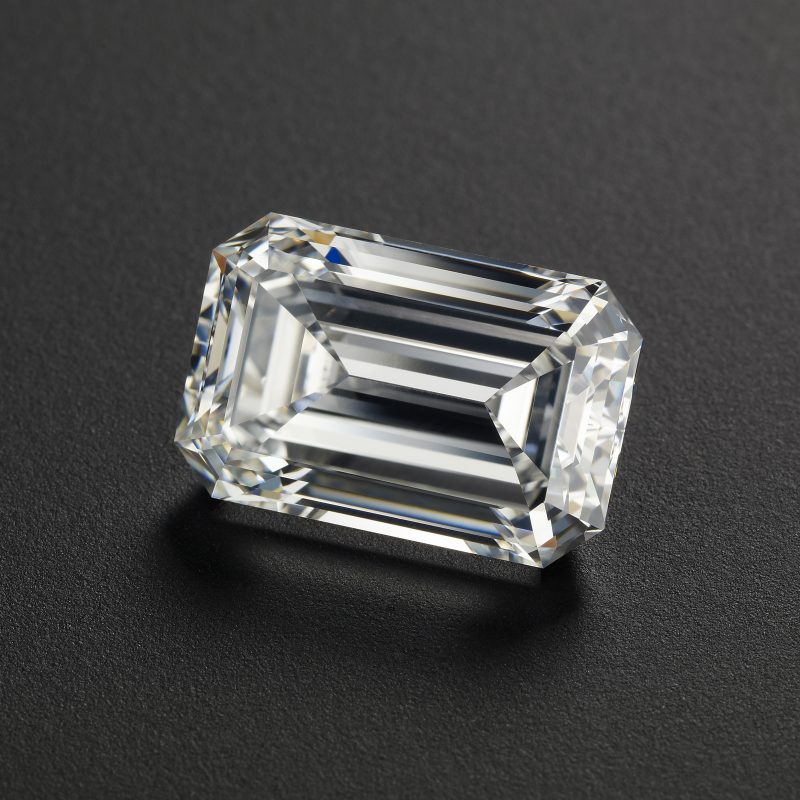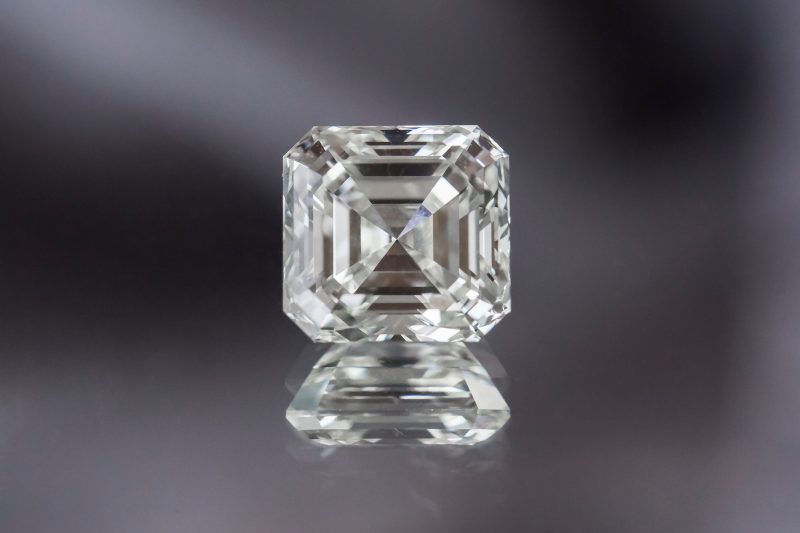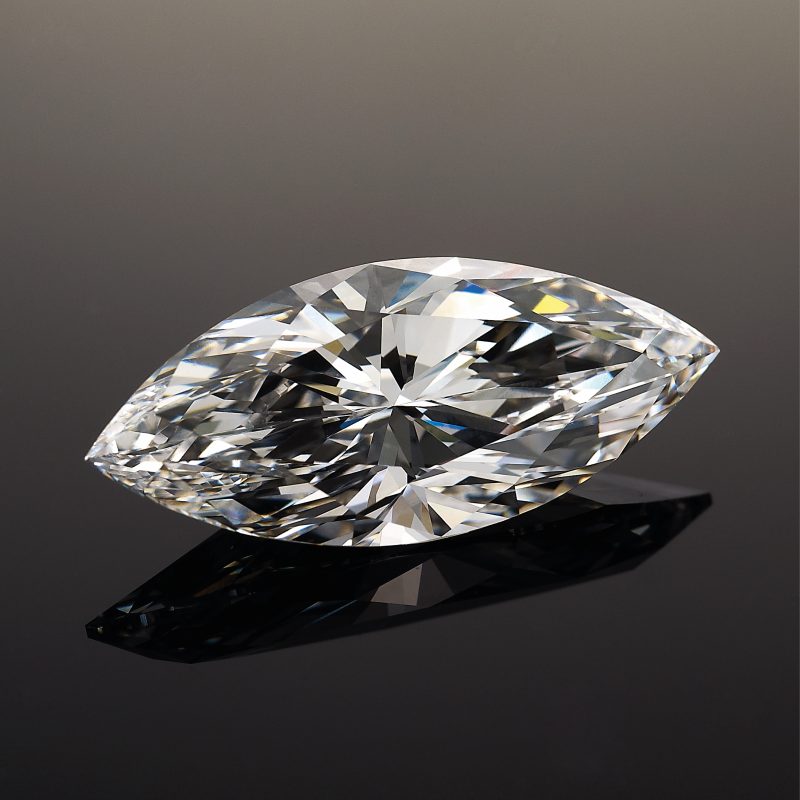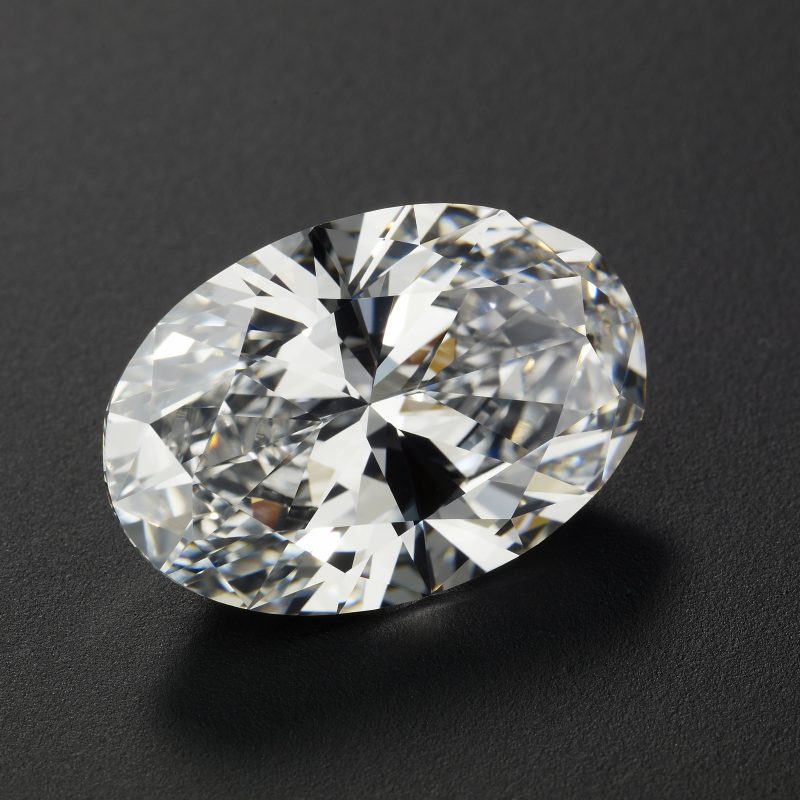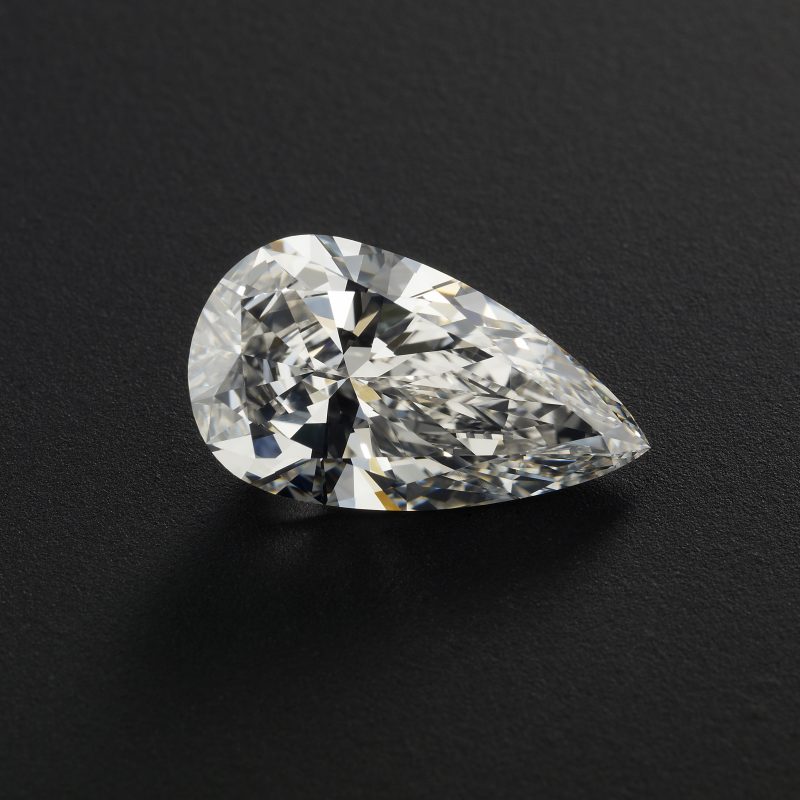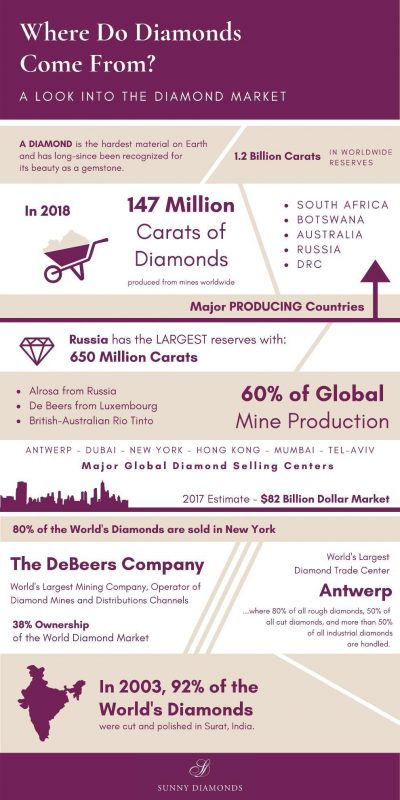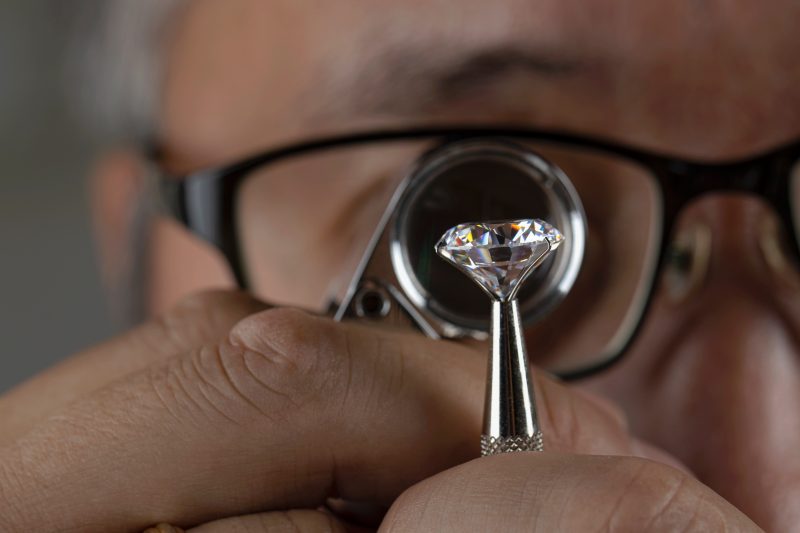Comprehensive Guide to Diamond Jewelry
How to Choose a Diamond
The 4 C’s
Cut
The cut is the most important factor to consider when buying a diamond. Diamonds are nothing without light, reflection and sparkle, and even a high-quality diamond will appear dull if it is not cut properly. When diamonds are cut ideally, the light that enters through the top of the diamond will be reflected through the cut and be redirected up to the eye, causing sparkle and luster. If a cut is too shallow,the light will escape through the bottom of the diamond.
Therefore, making sure you have the best cut is essential to making sure you have a breathtaking diamond that will glow for generations.
Color
After cut, the second most important factor in choosing a diamond is color. The highest quality diamonds are completely colorless, while lower-grade diamonds have a noticeable color, usually a pale yellow. The Gemological Institute of America (GIA) grades diamonds on a scale of D (colorless) to Z (light yellow or brown). D-Z diamonds are all known as white diamonds, even though the color may vary.
The somewhat odd scale (starting at D) comes from an old system of rating diamond color as A, B, and C. There are six categories on the GIA diamond chart, with color grades that range from absolutely clear to light in color. D-rated diamonds are the rarest and have no noticeable color, whereas G color and H color diamonds are nearly colorless, and since they are priced lower they are an excellent value for buying on a budget. The lower you move down the chart, the more apparent the yellow tint becomes.
D-F diamonds are the rarest, perfectly white diamonds, while G-H has no obviously detectable color and are the best budget items, as well as I-J diamonds.
Colored Diamonds
A very few diamonds have a strong color that is considered rare and valuable. These diamonds, unlike white diamonds, are purchased for the intensity and richness of their color. With these diamonds, clarity and cut proportions are less important, because the sparkle of a perfectly white clear diamond is not the goal. The 4 Cs of colored diamonds are as follows:
- ● Color – Color intensity, the deepness or richness of color, is the most important consideration when choosing a colored diamond. The more intense the color, the rarer and more valuable the diamond will be.
- ● Carat – After color grade, carat weight has the most impact on the price of colored diamonds. As colored diamonds are rare, it’s even more unusual to find one of large size. This makes large colored diamonds more valuable. For this reason, diamond prices rise dramatically with carat weight.
- ● Clarity – Due to the nature of colored diamonds, clarity is less important than a white diamond. This is because inclusions and blemishes are masked by the diamond’s color.
- ● Cut – Colored diamonds are primarily cut to emphasize their color. This contrasts with colorless diamonds that are cut to maximize sparkle or brilliance, which in some instances can detract from the natural color of the colored diamond. While colored diamonds can still be lustrous, color is the most important characteristic considered when they are being cut.
Clarity
Diamond clarity is the assessment of tiny microscopic imperfections on the surface and interior of the diamond. The surface imperfections are called blemishes and the interior problems are called inclusions.
Inclusions are common, as diamonds are imperfect minerals mined in imperfect conditions. Experts refer to inclusions by their “internal characteristics.” Such characteristics include things like clouds, feathers, crystals or other minerals, knots, cavities, cleavage, and internal graining. Examples of blemishes include polish lines, scratches, nicks, pits, chips, breaks, and dark or light spots.
In 1953, the GIA established a diamond grading system and clarity scale. There are six categories of clarity grading.
Diamond clarity guide
● FL – Flawless
o Flawless diamonds make up only 1% of all diamonds and have no blemishes or inclusions visible under 10x magnification.
● IF – Internally Flawless
o Internally Flawless diamonds have no inclusions visible under 10x magnification but may have some small surface blemishes.
● VVS – Very, Very Slightly Included
o VVS Diamonds have tiny inclusions that are difficult to see even under 10x magnification. A VVS 2 has slightly more inclusions than a VVS 1. Despite being ranked third, these are still considered excellent diamonds.
● VS – Very Slightly Included
o These are good, middle-of-the-road diamonds that have very minimal inclusions (which are still only visible under 10x visibility). VS 1 is higher quality than a VS 2, but both are inferior to VVS diamonds. Still, these are a great budget diamond, as the inclusions are noticeable to the naked eye and still maintain the diamond’s luster and brilliance.
● SI – Slightly Included
o Inclusions are noticeable at 10x magnification with SI diamonds. With SI1 diamonds the inclusions are sometimes visible to a perceptive eye without magnification. SI2 diamonds have inclusions that are usually visible to the naked eye.
● I1 – Included
o Inclusions are visible to the naked eye.
● I2, I3 – Heavily Included
o These diamonds have obvious inclusions. Most heavily included diamonds are not used in large jewellery.
Generally speaking, VS and SI diamonds are the most common, IF and F diamonds are very rare and therefore more valuable. And, as most inclusions are not visible except under magnification, this clarity issue isn’t a major deterrent to most buyers.
Diamond shape and size can affect clarity in different ways. Some diamond shapes require a higher clarity than others. Emerald cuts, for example, are designed with large rectangular faces that are designed to let you see far down into the diamond, which makes inclusions more visible. For these types of shapes, a VS1 or higher is recommended.
On the other hand, round, princess, oval, marquise, pear, and heart-shaped diamonds may not require as high of a clarity grade. Cut with a facet pattern where light reflects in many angles, these shapes naturally hide inclusions.
And when it comes to carat, the bigger the diamond and larger the facets, the more likely it will be for inclusions to be visible.
Diamond Grading Factors for Clarity
When diamonds are graded, they are magnified 10x. The clarity of the diamond is based on the most notable inclusions, but any characteristics that don’t get factored into the grade are still included on a diamond plot chart.
The five-diamond clarity factors are:
● Size – The size of the inclusion or blemish is the first thing looked at when grading a diamond. The larger or more noticeable the characteristic, the lower the grade.
● Number – Next is the number of easily-seen characteristics (note: this is not necessarily the total number of characteristics.) Having fewer characteristics leads to a higher grade.
● Position – The position of the characteristic is important. If it’s in a more noticeable place, such as close to the surface, it will receive a lower grade.
● Nature – This refers to whether the characteristic is internal or external. An internal characteristic cannot be graded as F or IF.
● Color and Relief – Color and relief is the measure of how easily seen the characteristic is, or how much contrast there is between the characteristic and the surrounding diamond.
Carat
Carat is the most misunderstood of the Four Cs. It refers to the diamond’s weight, not the size. (Note: “Carat” refers to diamond weight. “Karat” refers to gold purity.)
When selecting a carat, there are two main factors to consider. First, the diamond’s top diameter. It is this distance that you will see as the stone is set into the ring. Second, the cut grade. A well-cut diamond that reflects light well will appear bigger than a larger, poorly-cut diamond. Therefore, a larger diameter and higher cut grade (Ideal to Excellent) will make smaller carats appear larger, whereas a smaller diameter and lower cut grade (Good, Fair, or Poor) will make a large-carat-weight diamond appear smaller.
Other things to keep in mind are that prices jump at full-carat and half-carat weights, so when buying on a budget a 1.9 carat ring will be substantially cheaper than a 2.0 carat ring, and the size difference will hardly be noticeable.
Also, the size of the finger affects the appearance of the ring. A smaller carat on a smaller finger may appear bigger than a larger carat on a larger finger.
Fluorescence
Fluorescence is the glow you sometimes see when a diamond emits visible light. Some diamonds fluoresce when in the presence of ultraviolet light—they glow with bluish light, or more rarely, a yellow or orange light. Not all diamonds fluoresce; only about 25% to 35% of diamonds emit light like this.
The GIA considers fluorescence an identifying characteristic, like the 4 Cs. A diamond’s fluorescence is graded by its intensity (None, Faint, Medium, Strong, and Very Strong).
While most fluorescence is noted under UV light, some Strong and Very Strong diamonds can emit fluorescence under outdoor conditions, making these highly rated diamonds more valuable. It is believed by some that a yellow-tinted fluorescent diamond can look clearer and whiter than yellow-colored non-fluorescent diamond.
But according to the GIA, “For the average observer, meant to represent the jewelry buying public, no systematic effects of blue fluorescence on the face-up appearance of the groups of diamonds were detected. Even experienced observers did not consistently agree on the effects of fluorescence from one stone to the next.”
Shape
Since all diamond cut styles are very different, unique characteristics determine quality for each shape.
Round-Cut Diamond
The round-cut diamond is easily the most popular and most common diamond shape available today. For more than a thousand years, diamond cutters have been using advanced theories of light behavior and precise mathematical calculations to optimize the luster and luminescence in a round diamond. In addition to being the most popular and historically common shape, round-cut diamonds will typically give you more options for balancing cut, color, and clarity grades while still getting the brilliance you desire in a diamond.
Princess-Cut Diamond
The most popular non-round diamond is the princess cut. It’s unique cut and beautiful plays with light makes it a favorite for engagement rings. The princess has pointed corners and is traditionally square or rectangular in shape. When choosing a color grade, be aware that lower color grades are more visible at the square corners of a princess cut and a higher-quality color might be desired. Also, princess-cut diamonds can vary greatly in how square or rectangular they are.
Emerald-Cut Diamond
What makes the emerald diamond shape different is its pavilion, or the lower half of the diamond, which in some shapes is hidden by the setting. Due to its larger, open table (the flat surface at the top of the diamond), this shape highlights the clarity of a diamond. You must, therefore, be careful selecting a lower clarity diamond, such as anything below an SI. Also, emerald-cut diamonds can vary greatly in how rectangular they are. If you’d prefer an emerald cut with a squared outline, look for an Asscher-cut diamond.
Asscher-Cut Diamond
This unique shape is nearly identical to the emerald-cut, except that it is square. The Asscher-cut diamond shape has a pavilion that is cut with rectangular facets in the same style as the emerald-cut. This shape highlights the clarity of the diamond, as with the emerald-cut, so a highly-graded clear diamond is an important consideration. As with the princess-cut, color grade is also important, as lower color grades will become evident in the corners of this generally square diamond.
Marquise-Cut Diamond
The shape of a marquise diamond gives you a lot of diamond for your budget, as a smaller-carat marquise gives you a much larger-looking diamond. This lustrous diamond looks gorgeous set with round or pear-shaped side stones, and the length of the marquise diamond gives a finger the appearance of being long and slender.
Oval-Cut Diamond
An oval diamond combines the beautiful brilliance of a round diamond with the carat-maximizing quality of a marquis. Oval diamonds are also very popular as their length can accentuate long, slender fingers.
Radiant-Cut Diamond
Clipped corners are the hallmark of this diamond, and they help make the radiant-cut a common and versatile choice for rings. Radiant-cut diamonds can vary in their degree of rectangularity.
Pear-Shaped Diamond
Also called a teardrop, this glowing diamond features a single point and rounded end. The unique look of the pear shape helps make it a popular choice for a variety of diamond jewelry. As with the marquis and oval, this has a slimming effect on the hand.
Heart-Shaped Diamond
This unique look helps make it a distinctive choice for a variety of diamond jewelry. As with other specialty shapes, with sharp corners, color grade is an important factor in a heart-shaped diamond. This shape comes in a variety of styles, as hearts can be wide and flat of stretched and elongated.
Cushion-Cut Diamond
This more old-fashioned cut has been popular for over a century, and with good reason. Cushion-cut diamonds (also known as “pillow-cut” diamonds) have rounded corners and larger facets to increase their luster and glow. These larger facets highlight the diamond’s clarity, so be sure you select a well-graded clear diamond. Cushion-cut diamonds are available in shapes ranging from square to rectangular.
Where Do Diamonds Come From?
A diamond is the hardest material on Earth and has long-since been recognized for its beauty as a gemstone. Some 147 million carats of diamonds were estimated to have been produced from mines worldwide in 2018. Major producing countries include Australia, the Democratic Republic of Congo, Botswana, South Africa, and Russia. Worldwide reserves are estimated to be some 1.2 billion carats. Russia has the largest reserves, estimated at some 650 million carats.
The global diamond mining industry is largely dominated by a hand-full of companies. Alrosa from Russia, De Beers from Luxembourg, and British-Australian Rio Tinto are the largest three and account for more than 60 percent of global diamond mine production. Mined diamonds are mostly processed in and sold via the major global diamond centers: Antwerp, Dubai, New York, Hong Kong, Mumbai, and Tel-Aviv.
Diamonds increase drastically in value through processing from production to retail. In 2017, for example, mined rough diamonds had a production value of some 17.5 billion U.S. dollars. After polishing, this figure increased to 25 billion U.S. dollars. In 2017, the global diamond jewelry market value was approximately 82 billion U.S. dollars. Nearly half of the world’s demand for polished diamonds comes from the United States, with a 48 percent share of global demand in 2017.
One hallmark of the trade of gem-quality diamonds is its remarkable concentration: wholesale trade and diamond cutting are limited to just a few locations. In 2003, 92% of the world’s diamonds were cut and polished in Surat, India.
The production and distribution of diamonds is largely consolidated in the hands of a few key players, concentrated in traditional diamond trading centers. The largest of these is in Antwerp, where 80% of all rough diamonds, 50% of all cut diamonds, and more than 50% of all industrial diamonds are handled. It is the home of the International Gemological Institute. Another important city is New York City, where 80% of the world’s diamonds are sold, including auction sales.
The DeBeers Company, the world’s largest diamond mining company, holds a dominant position in the industry and has done so since 1888. DeBeers is currently the largest operator of diamond mines and distribution channels. But while they once controlled 80% of the world diamond market, their market share is now estimated to be around 38% in value. DeBeers is often credited for starting the worldwide diamond market, with their earth shattering 1930s “diamonds are forever” campaign, which made diamond rings synonymous with weddings. Prior to that, rubies and emeralds were the most common wedding ring stones, dating back to the fifteenth century.
The World Federation of Diamond Bourses acts as a medium for the wholesale diamond exchange, trading both polished and rough diamonds. In 2000, the WFDB and The International Diamond Manufacturers Association established the World Diamond Council to prevent the trading of conflict diamonds.
Chemical Composition
Diamond is the solid form of the element carbon with its atoms arranged in a crystal structure called “diamond cubic.” It has the highest hardness and thermal conductivity of any natural material. Because of the arrangement of the atoms, few types of impurities can contaminate a diamond. Small impurities create colored diamonds such as blue (boron), yellow (nitrogen), brown (defects), green (radiation exposure), purple, pink, orange, and red.
Most natural diamonds are between one to three-and-a-half billion years old, and most were formed deep in the earth’s mantle, between 100 and 150 miles below ground, and some have come from as deep as 500 miles. These diamonds were brought to the surface in volcanic eruptions and deposited in igneous rocks such as kimberlites and lamproites.
It is a common misconception that diamonds are formed from hardened coal. Coal is formed from prehistoric plants, and most diamonds are far older than the earliest known land plants.
Although rare on Earth, diamonds are common in space. In meteorites, about three percent of the carbon is nanodiamonds. High pressure experiments predict that large quantities of diamonds condense in methane into “diamond rain” on the ice giant planets of Neptune and Uranus. It’s hypothesized that some planets in other solar systems may be entirely composed of diamonds.
Diamond Cutting
Mined rough diamonds are converted into gems through a process called “cutting”. Diamonds are extremely hard, but also brittle and can be split by a single blow. Therefore, diamond cutting is traditionally considered as a delicate procedure requiring skills, scientific knowledge, tools and experience. The final goal of cutting is to produce a multi-faceted jewel where the specific edges and angles of the facets optimize the stone’s luster.
The most time-consuming part of the process is the preliminary analysis of the rough stone. It needs to address numerous issues, bears much responsibility, and can therefore take years in the case of unique diamonds. Things to consider when cutting are: the hardness of the diamond and its ability to cleave in the optimal cutting directions; the inclusions and flaws; and the proper tool to use to perform the cutting (a diamond can be split with a single strike, or it can be cut with a diamond saw.)
Industrial-Grade Diamonds
Industrial diamonds are valued for their hardness and thermal conductivity, making the gemological characteristics of diamonds (the 4 Cs) irrelevant. 80% of mined diamonds (approximately 135 million carats) are unsuitable for use as gemstones and are used industrially. In addition to mined diamonds, synthetic diamonds found use almost immediately after they were invented, in the 1950s. 570 million carats of synthetic diamond are produced annually, 90% coming from China.
Diamonds are used in saws, drill bits, and grinding tools, and diamond powder is used as an abrasive. Aside from hardness qualities, their thermal conductivity makes them a good heat sink in electronic integrated circuits.
Conflict Diamonds
Also known as blood diamonds, war diamonds, or hot diamonds, these are stones that are mined in a war zone and sold to finance an insurgency, an invading army’s war efforts, or a warlord’s activities. Diamonds mined in recent decades in Angola, Ivory Coast, Sierra Leone, Liberia, Guinea and Guinea Bissau have all been given the label.
The United Nations addressed the issue in 1998 and again in 2000, leading to a Security Council resolution in which conflict diamonds could be identified, the trade could be halted, and buyers could be confident that their purchase did not contribute to violence. New technology, including the use of a blockchain database, allows for the tracking of diamonds from mines all the way to jewellery stores.
Famous Diamonds
Many diamonds have been world-record holders or have held prominent places in modern and historical culture.
Perhaps none is more famous than the Hope Diamond. The stone, having originated in India, is a brilliant blue due to boron content. It weighs over 45 carats and was first sold in 1666. After traveling through many owners, it now resides in the United States National Museum of Natural History, where it is insured for $250 million.
In 2009, a 7.03 carat blue diamond drew the highest price-per-carat of any diamond, selling for $9.5 million at the time. However, that record was beaten later that year when a 5-carat bright pink diamond was sold in China for $10.8 million.
The largest ever diamond rough-cut diamond ever found was the Sergio, a 3,167-carat diamond found in Brazil, the apparent remnant of a meteorite. With too many inclusions to ever be a magnificent piece, it was sold for in 1895 for $25,000 to be broken up and used in industrial usages.
The largest gem-quality diamond ever found was the Cullinan Diamond, weighing in at 3106 carats. It was cut into many smaller gems, the largest of which is known as the Star of Africa, a 530-carat piece, the largest clear-cut diamond in the world. It is mounted in the Sovereign’s Scepter of the Cross, the British ornamental rod held by the monarch during the coronation. It is kept with the Crown Jewels in the Tower of London.
Famous Movies and Books Featuring Diamonds
As diamonds have an almost magnetic draw on the minds of the public, there’s no surprise that diamonds have played a major role in major books and movies.
Heart of the Ocean: This fictional blue diamond was featured in the 1997 film Titanic, playing a major role in the modern-day part of the story, with treasure hunters eagerly seeking to find it in the wreckage. A 56-carat diamond, originally belonging to Louis XVI, was cut into an oval shape after the French Revolution. It is considered by many to be based on the real-life large blue diamond, the Hope Diamond.
The Pink Panther: Although much confusion was caused by the eponymous cartoon cat, the Pink Panther was the name of the diamond in the original movie of the same name. The diamond in the movie was given to a princess by the Shah of Lugash and is believed to be based on the Nur-Al-Ain, a 60-carat gem in the tiara worn by Empress Farah when she married the Shah of Iran in 1958. To add to the confusion, another real-life diamond, the Darya-i-Nur, a 186-carat diamond in the Iranian Crown Jewels has been referred to as the Pink Panther and was sold in 2010 for a record $46 million.
Sex and the City Wedding Ring: In the second Sex and the City movie, Carrie is married to Mr. Big with a 5-carat black diamond. When asked why it was black, Mr. Big says “Because you are not like anyone else.”
The Fabulous Baseball Diamond: In the Great Muppet Caper, the Muppets must save Lady Holiday’s (Diana Rigg) Baseball Diamond “The biggest diamond in the world.” On display in the Mallory Gallery, Kermit, Fozzie, Gonzo and friends hold off the thieves with a rousing game of baseball, using the stone.
Diamonds Are Forever: In this, the last James Bond movie to star Sean Connery, South African diamonds are being stockpiled to depress diamond prices by “dumping” and Bond is put on the case to uncover the smuggling ring. It turns out arch enemy Blofeld was using the diamonds to construct a laser satellite with the aim of destroying all nuclear weapons.
A Diamond as Big as The Ritz: F. Scott Fitzgerald wrote of a diamond so big that if it was to be cut into small diamonds it would flood the market and cause the entire price of diamonds to collapse. The story is a cautionary tale, as the family tries to keep the diamond a secret, but is ultimately undone by greed, jealousy and fear.
Bibliography:
How to choose a diamond:
Wikipedia: Diamond Gemstones
Sunny Diamonds Diamond Guide
Gemological Institute of America
Diamond Shape
Where Did Diamonds Come From?
Wikipedia: Diamond Geology
Wikipedia: Diamond Modern History
Wikipedia: DeBeers
Chemical Composition
Wikipedia: Diamond Material Properties
The Nature of Diamonds, Google Books
Wikipedia: Diamond Color
Wikipedia: Diamond Cutting
Encyclopedia Brittanica: Industrial Diamond
Conflict Diamonds
CNN: What are conflict diamonds?
Wikipedia: Blood Diamond
Famous Diamonds
Wikipedia: Cullinan Diamond
Fictional Diamonds


